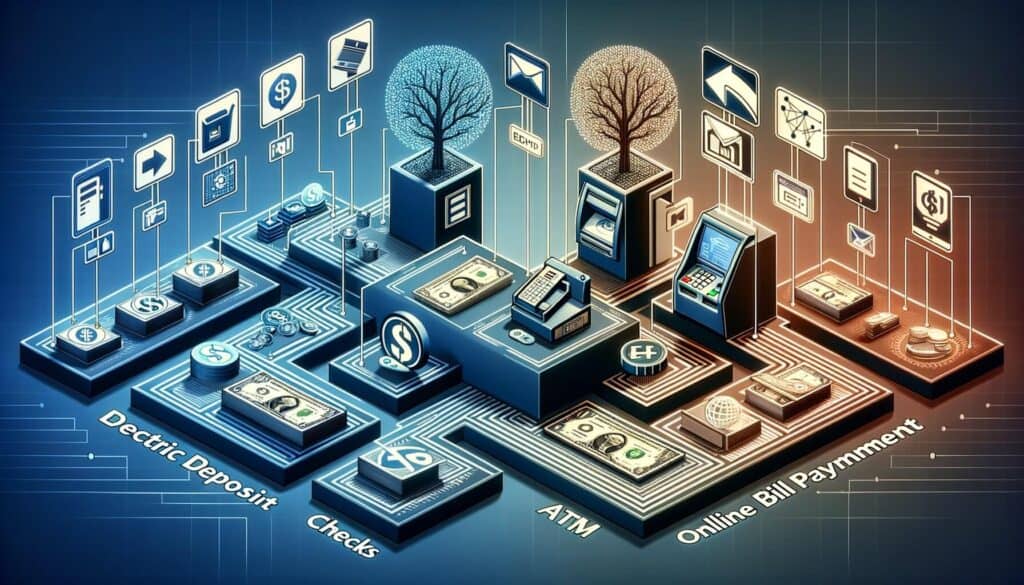
By Catharine Proctor April 2, 2025
Electronic Funds Transfer (EFT) payments have revolutionized the way we handle financial transactions. In today’s digital age, where convenience and speed are paramount, EFT payments offer a secure and efficient method of transferring funds electronically. Whether you are a business owner looking to streamline your payment processes or an individual seeking a hassle-free way to pay bills, understanding the ins and outs of EFT payments is essential.
In this comprehensive guide, we will delve into the world of EFT payments, exploring how they work, the different types available, the benefits they offer, and the steps involved in setting them up. We will also discuss the security measures in place to ensure safe transactions, common challenges faced, and solutions to overcome them.
Additionally, we will provide insights into choosing the right Electronic Funds Transfer (EFT) payment provider and address frequently asked questions to help you gain a thorough understanding of this payment method.
How EFT Payments Work: A Step-by-Step Guide

Electronic Funds Transfer (EFT) payments involve the electronic transfer of funds from one bank account to another, eliminating the need for physical checks or cash. The process typically involves the following steps:
Step 1: Initiation – The payment process begins when the payer (the individual or business making the payment) initiates the transaction. This can be done through various channels, such as online banking platforms, mobile apps, or payment gateways.
Step 2: Authorization – Once the payer initiates the payment, the authorization process takes place. This involves verifying the payer’s identity and ensuring they have sufficient funds to cover the transaction. The payer’s bank or financial institution plays a crucial role in this step.
Step 3: Transmission – After authorization, the payment details are transmitted securely from the payer’s bank to the payee’s bank. This transmission can occur through various electronic channels, such as the Automated Clearing House (ACH) network or wire transfers.
Step 4: Clearing and Settlement – The payee’s bank receives the payment details and processes them for clearing and settlement. This involves verifying the authenticity of the transaction and ensuring the funds are transferred to the correct account.
Step 5: Notification – Once the payment is successfully cleared and settled, both the payer and payee receive notifications confirming the transaction. This notification can be in the form of an email, SMS, or a message within the banking app.
Types of EFT Payments: A Comprehensive Overview

EFT payments encompass a wide range of electronic transactions, each serving a specific purpose. Let’s explore some of the most common types of Electronic Funds Transfer (EFT) payments:
1. Direct Deposit – Direct deposit is a popular form of Electronic Funds Transfer (EFT) payment used by employers to deposit employees’ salaries directly into their bank accounts. It eliminates the need for physical paychecks and provides employees with quick access to their funds.
2. Electronic Bill Payment – Electronic bill payment allows individuals to pay their bills electronically, such as utility bills, credit card bills, or mortgage payments. This method offers convenience, as it eliminates the need for writing checks or visiting physical payment centers.
3. Wire Transfers – Wire transfers are a type of Electronic Funds Transfer (EFT) payment that enables the transfer of funds between different banks or financial institutions. They are often used for large transactions or international transfers, as they provide a fast and secure method of sending money.
4. Automated Clearing House (ACH) Payments – ACH payments are electronic transfers that facilitate various types of transactions, including direct deposits, bill payments, and business-to-business payments. ACH payments are processed in batches, making them cost-effective and efficient.
5. Mobile Payments – With the rise of smartphones, mobile payments have gained popularity. These payments allow individuals to make purchases or transfer funds using mobile apps or digital wallets, such as Apple Pay or Google Pay.
Benefits of EFT Payments for Businesses and Individuals

EFT payments offer numerous benefits for both businesses and individuals. Let’s explore some of the advantages they provide:
1. Convenience – EFT payments offer unparalleled convenience, allowing individuals and businesses to make transactions from the comfort of their homes or offices. This eliminates the need for physical checks, cash, or visits to payment centers.
2. Speed – Electronic Funds Transfer (EFT) payments are significantly faster than traditional payment methods. With electronic transfers, funds can be transferred within minutes or hours, depending on the type of payment. This speed is particularly beneficial for businesses that need to process large volumes of transactions quickly.
3. Cost Savings – EFT payments can result in significant cost savings for businesses. By eliminating the need for paper checks, envelopes, and postage, businesses can reduce administrative costs associated with payment processing. Additionally, Electronic Funds Transfer (EFT) payments often have lower transaction fees compared to other payment methods.
4. Security – EFT payments offer enhanced security compared to physical checks or cash. With encryption and authentication measures in place, the risk of fraud or theft is minimized. Additionally, electronic records of transactions provide a trail of evidence, making it easier to track and resolve any discrepancies.
5. Improved Cash Flow – For businesses, EFT payments can improve cash flow management. With faster payment processing, businesses can receive funds more quickly, allowing them to meet financial obligations and invest in growth opportunities.
Setting Up EFT Payments: Requirements and Procedures

Setting up EFT payments involves a few key requirements and procedures. Let’s explore the steps involved:
1. Bank Account – To initiate EFT payments, both the payer and payee must have a bank account. This account serves as the source or destination for the funds being transferred. It is essential to ensure that the bank account is active and in good standing.
2. Authorization – Before initiating Electronic Funds Transfer (EFT) payments, the payer must authorize their bank or financial institution to transfer funds electronically. This typically involves completing an authorization form or providing consent through online banking platforms.
3. Payment Gateway or Service Provider – Depending on the type of EFT payment, a payment gateway or service provider may be required. For businesses, this could involve integrating with a payment processor or using a third-party service provider to facilitate transactions.
4. Account Verification – To ensure the accuracy of EFT payments, account verification is necessary. This involves confirming the account details of the payee, such as the account number and routing number. This step helps prevent errors and ensures the funds are transferred to the correct account.
5. Testing and Implementation – Once the necessary requirements are met, it is crucial to test the EFT payment system before full implementation. This involves conducting trial transactions to ensure the system is functioning correctly and that funds are being transferred accurately.
Security Measures in EFT Payments: Ensuring Safe Transactions
Security is a top priority when it comes to Electronic Funds Transfer (EFT) payments. To ensure safe transactions, various security measures are in place. Let’s explore some of the key security measures:
1. Encryption – EFT payments utilize encryption technology to protect sensitive information during transmission. Encryption converts data into a coded format, making it unreadable to unauthorized individuals. This ensures that payment details, such as account numbers and personal information, remain secure.
2. Authentication – Authentication measures are used to verify the identity of individuals involved in EFT payments. This can include passwords, PINs (Personal Identification Numbers), or biometric authentication methods, such as fingerprint or facial recognition. These measures help prevent unauthorized access to accounts and ensure that only authorized individuals can initiate transactions.
3. Fraud Detection – EFT payment systems employ sophisticated fraud detection mechanisms to identify and prevent fraudulent activities. These systems analyze transaction patterns, monitor for suspicious behavior, and employ machine learning algorithms to detect and flag potential fraudulent transactions.
4. Secure Networks – Electronic Funds Transfer (EFT) payments rely on secure networks to transmit payment data. These networks utilize firewalls, intrusion detection systems, and other security protocols to protect against unauthorized access or data breaches. Regular security audits and updates are conducted to ensure the network remains secure.
5. Compliance with Regulations – EFT payment providers must comply with various regulations and industry standards to ensure the security of transactions. This includes adhering to data protection laws, such as the General Data Protection Regulation (GDPR), and implementing measures to prevent money laundering and fraud.
Common Challenges and Solutions in EFT Payments
While EFT payments offer numerous benefits, they are not without their challenges. Let’s explore some common challenges faced in Electronic Funds Transfer (EFT) payments and potential solutions:
1. Technical Issues – Technical issues, such as system downtime or connectivity problems, can disrupt EFT payment processes. To mitigate these challenges, it is essential to have robust backup systems in place, conduct regular maintenance, and work with reliable service providers.
2. Payment Rejections – EFT payments can be rejected for various reasons, such as insufficient funds, incorrect account details, or account closures. To address this challenge, it is crucial to verify account details before initiating payments and promptly resolve any issues that arise.
3. Security Threats – EFT payments are susceptible to security threats, such as hacking or phishing attacks. To combat these threats, it is essential to implement robust security measures, educate users about potential risks, and regularly update security protocols to stay ahead of evolving threats.
4. Compliance and Regulatory Requirements – EFT payments must comply with various regulations and industry standards. To address compliance challenges, it is crucial to stay updated on regulatory changes, work with reputable payment providers, and implement internal controls to ensure adherence to regulations.
5. Customer Support – Providing prompt and efficient customer support is crucial in addressing any challenges or concerns that customers may have regarding EFT payments. Offering multiple channels of communication, such as phone, email, or live chat, can help resolve issues quickly and enhance customer satisfaction.
EFT Payment Providers: Choosing the Right Service for Your Needs
Choosing the right EFT payment provider is essential to ensure smooth and secure transactions. When selecting a service provider, consider the following factors:
1. Reputation and Reliability – Look for a reputable and reliable EFT payment provider with a proven track record. Research customer reviews, testimonials, and industry rankings to gauge the provider’s reputation and reliability.
2. Security Measures – Ensure that the payment provider has robust security measures in place to protect your transactions and sensitive information. Look for features such as encryption, authentication protocols, and compliance with industry standards.
3. Integration and Compatibility – If you are a business, consider the compatibility of the payment provider’s system with your existing infrastructure. Ensure that the provider offers seamless integration with your accounting software, e-commerce platform, or other systems you use.
4. Cost and Fees – Evaluate the cost structure and fees associated with the EFT payment provider. Consider factors such as transaction fees, monthly fees, setup fees, and any additional charges. Compare pricing models and choose a provider that offers competitive rates without compromising on quality.
5. Customer Support – Assess the level of customer support provided by the payment provider. Look for providers that offer 24/7 customer support, multiple channels of communication, and a dedicated support team to address any issues or concerns promptly.
Frequently Asked Questions about EFT Payments
Q1. What is the difference between EFT and ACH payments?
Answer: EFT payments encompass a broader range of electronic transactions, including ACH payments. ACH payments specifically refer to electronic transfers processed through the Automated Clearing House network.
Q2. Are EFT payments secure?
Answer: Yes, EFT payments are secure. They employ encryption, authentication measures, and other security protocols to protect sensitive information and prevent unauthorized access.
Q3. How long does it take for an EFT payment to clear?
Answer: The time it takes for an EFT payment to clear depends on various factors, such as the type of payment, the banks involved, and any processing delays. In general, EFT payments can clear within minutes to a few business days.
Q4. Can EFT payments be reversed?
Answer: EFT payments can be reversed under certain circumstances, such as if the payment was made in error or if fraudulent activity is detected. However, reversing an EFT payment may require the involvement of the payer’s and payee’s banks.
Q5. Can EFT payments be used for international transfers?
Answer: Yes, EFT payments can be used for international transfers. Wire transfers are commonly used for international EFT payments, as they provide a fast and secure method of transferring funds across borders.
Conclusion
EFT payments have transformed the way we handle financial transactions, offering convenience, speed, and enhanced security. Whether you are a business owner looking to streamline payment processes or an individual seeking a hassle-free way to pay bills, understanding EFT payments is crucial. In this comprehensive guide, we explored the intricacies of EFT payments, including how they work, the different types available, the benefits they offer, and the steps involved in setting them up.
We also discussed the security measures in place to ensure safe transactions, common challenges faced, and solutions to overcome them. Additionally, we provided insights into choosing the right EFT payment provider and addressed frequently asked questions to help you gain a thorough understanding of this payment method.
By embracing EFT payments, businesses can improve efficiency, reduce costs, and enhance cash flow management. Individuals can enjoy the convenience and security of electronic transactions, making their financial lives easier. As technology continues to advance, EFT payments will undoubtedly play an increasingly significant role in our financial landscape.